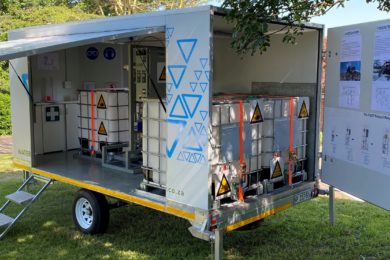Water specialist Talbot has launched a state-of-the-art mobile unit that enables mining and mineral resources players to test a highly efficient and cost-effective water treatment and mineral product recovery solution, right on site. The mobile unit with its fully-equipped test laboratory gives clients a clear demonstration of the effectiveness of Vibrating Sheer Enhanced Process (VSEP) technology, a solution developed by US company New Logic Research Inc.
This solution not only treats highly contaminated and difficult water streams to municipal quality but is able to recover valuable product from residue that would otherwise be consigned to waste. “VSEP achieves in a single stage what traditional reverse osmosis solutions typically cannot accomplish even with significant pretreatment. Often piloted as a last resort on very contaminated streams, VSEP is typically the most effective, simple and easy to operate.” says Talbot Consulting Services general manager Claire Lipsett.
The technology adds significant value through the concentration of brine streams, making it ideal for sites seeking to defer costs where brine storage facilities are nearing capacity. Trials at one Mpumalanga-based coal mine have projected a 50% reduction in daily brine production which would mitigate the risk of overflow and enable future expansion. It also substantially enhances the recovery of high-quality water for use in site activities, as a substitute for municipal supply or be taken up by water-stressed local communities.
“Miners and precious metals refineries benefit from the recovery of large quantities of ultra-fine particles of product from their waste streams that can be returned to the process,” she says. A number of South African case studies reveal that through VSEP’s ability to salvage usable product, payback time with a product recovery focus is typically under six months offering substantial long-term savings, in addition to water-saving benefits and environmental compliance.
The mobile treatment facility and laboratory site operations are essential to develop in-house technical and financial models, to demonstrate the potential of utilising VSEP within a given operation. The information derived serves as the basis for a full plant design and supports the preparation of business cases looking five and 10 years into the future. “Nothing beats live data – on your site, on your water. Potential customers are able to look, see and ask questions, and have the assurance that the design is based on their specific conditions.”
Lipsett adds that piloting achieves accuracy that desktop design simply can’t. “We’re able to characterise the streams of interest, optimise the full plant design, gain firm details on operating costs and save the client money by factoring in unknowns. In short, operations can make a ‘yes’ or ‘no’ call, remove the risk and maximise the benefits of investing in innovative technology,” she says.
“Talbot has developed purpose-built financial models which allows us to assess the life-cycle cost and long-term viability of each project. We work with clients to make their projects cashflow positive so that savings and product recovery pay for the plant itself. We also provide the opportunity for clients to rent or lease equipment,” says Talbot economist Mike Smith
Financial projections of conceptual models designed during the piloting process include not only the original capital cost of the equipment but anticipated expenditure on items like membrane replacement and operational and maintenance costs. “This provides potential users with a comprehensive set of economic life-cycle projections, thus enabling clients to make informed decisions on the short, medium and long-term benefits with no hidden costs. This provides a complete offering to our clients working to make informed decisions on innovative, market-changing technologies”.










